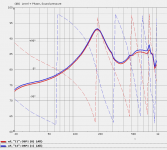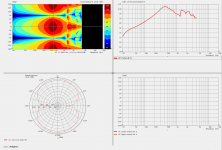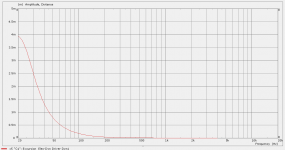For best results I would make the baffle thicker around the woofers. E.g. 2x18mm or even 40mm. Try to find better quality MDF like v313 or at least Medite. Or even better is birch multiplex... (Or sandwich of MDF+MPX)
Hi fedde,
i have concerns that this will make me lose the bass extension @20hz.
I don't know how the nxt-like bass extension will differ with mpx... Do you have experience?
Why would the bass extensions be less with thicker baffle or multiplex? In any case 20 Hz is too ambitious for open baffle. 40 Hz -3 dB is more realistic, perhaps a little lower...
In the graph we can see to much bass. From 20H-40Hz +6db in comparison with the simulated Bassresponse. There was a discussion where it comes from. With a acceleration measure unit they found out, that the additional bassresponse comes from the baffle. But not in sense of bad resonances. More like a nxt or dml.
Therefore i have concerns to lose this nice bass response with thicker or other wood.
Best regards, Tomas
Here's a way to fix that problem: don't use a baffle. Also, don't try to make a system with limited front to back pathlength reproduce low bass (below 80Hz) but instead have a separate subwoofer. A mono sub works like a table to put your amplifiers, TV or whatever on, up front and in between the speakers. It could be dipole or closed box. Then you are free to have a minimal or no-baffle OB/dipole. A 3-way works great.
Unfortunately i have to make some changes in the bass section. The reason: WAF.
Nevertheless i have build now a H-Frame with the w4-1320sj and the grs 3,5 planar (similar like neo3) on the top.
The distortion profile of the w4-1320sj changed dramativcally with the attachment of this tangband. The first test without baffle showed more definitiv more distortion, then on other measurement on the internet. 😱
Luckily my biggest holesaw have a diameter of 9,4 cm. This is 1-2 mm to small. I tried it and pressed the w4-1320sj firmly in the hole. It was only possible to press it in the hole from one side of the wood.😱
It was so firm, that id didnt had to attach some screws. I took a measurement: Perfect!!! After this i have widen the holes in the wood 1cm. But the distortion was again to high.
So if somebody use this driver, this is really good to know.😎
The ADAU1701 DSP + 1* PCM5102 + 1* 7.1AVR runs good. I have equlized (only some changes from a first on-Axis measurement) and made a XO in Sigmastudio with LR24 at 300HZ and at 2300Hz. It sound overall really good. Especially some audiophile CDs and some Liveconcert are very nice.
In the End of this week i will make some measurement and post it here. I would like to test different Crossovers (LR24, with without FIR, Duelund, Harsch XO, LR12). I want to simulate them in VituixCad and then implement them in SigmaStudio under different Profiles, to make a A B comperasion.
I am still at the beginning to make good crossovers, so i would really appriciate your help in this stuff.
Still open questions:
Where i have the biggest undiscovered potential for a better soundqualitiy....
DAC
At the Moment i have 4 analog outs direct from the DSP and two digital outs to the PCM 5102. I could buy 2 more PCM5102 because these seems to be better than the intigrated DAC inside the DSP. Other recommendations till 100 $?
DSP
What i have read, only for more or better FIR filter i probably need better DSP. So at the moment still not required.
AMP
The goal is to have AMP-Boards inside the speaker enclosure. At home i have a DTA-1 Amp and two Symasyms. The Symasym is a little better but its not so a big difference. (For example i have a Mezmerize DB1 Hot Rodded. If i use it i can hear right away a big and good difference).
So what Amps to buy till 150$ (No problem to get it from China)...
3E Audio TPA3255
LJM L12-2
ICEPower
Hypex UcD36MP
Alternatives?
Thank you very much, and sorry for my english😱
Tomas
Nevertheless i have build now a H-Frame with the w4-1320sj and the grs 3,5 planar (similar like neo3) on the top.
The distortion profile of the w4-1320sj changed dramativcally with the attachment of this tangband. The first test without baffle showed more definitiv more distortion, then on other measurement on the internet. 😱
Luckily my biggest holesaw have a diameter of 9,4 cm. This is 1-2 mm to small. I tried it and pressed the w4-1320sj firmly in the hole. It was only possible to press it in the hole from one side of the wood.😱
It was so firm, that id didnt had to attach some screws. I took a measurement: Perfect!!! After this i have widen the holes in the wood 1cm. But the distortion was again to high.
So if somebody use this driver, this is really good to know.😎
The ADAU1701 DSP + 1* PCM5102 + 1* 7.1AVR runs good. I have equlized (only some changes from a first on-Axis measurement) and made a XO in Sigmastudio with LR24 at 300HZ and at 2300Hz. It sound overall really good. Especially some audiophile CDs and some Liveconcert are very nice.
In the End of this week i will make some measurement and post it here. I would like to test different Crossovers (LR24, with without FIR, Duelund, Harsch XO, LR12). I want to simulate them in VituixCad and then implement them in SigmaStudio under different Profiles, to make a A B comperasion.
I am still at the beginning to make good crossovers, so i would really appriciate your help in this stuff.
Still open questions:
Where i have the biggest undiscovered potential for a better soundqualitiy....
DAC
At the Moment i have 4 analog outs direct from the DSP and two digital outs to the PCM 5102. I could buy 2 more PCM5102 because these seems to be better than the intigrated DAC inside the DSP. Other recommendations till 100 $?
DSP
What i have read, only for more or better FIR filter i probably need better DSP. So at the moment still not required.
AMP
The goal is to have AMP-Boards inside the speaker enclosure. At home i have a DTA-1 Amp and two Symasyms. The Symasym is a little better but its not so a big difference. (For example i have a Mezmerize DB1 Hot Rodded. If i use it i can hear right away a big and good difference).
So what Amps to buy till 150$ (No problem to get it from China)...
3E Audio TPA3255
LJM L12-2
ICEPower
Hypex UcD36MP
Alternatives?
Thank you very much, and sorry for my english😱
Tomas
Here's a way to fix that problem: don't use a baffle. Also, don't try to make a system with limited front to back pathlength reproduce low bass (below 80Hz) but instead have a separate subwoofer. A mono sub works like a table to put your amplifiers, TV or whatever on, up front and in between the speakers. It could be dipole or closed box. Then you are free to have a minimal or no-baffle OB/dipole. A 3-way works great.
Hi CHarlieLaub,
you are right. With 3 Way i thought always to have onlye the con that i push much stress on the driver and therefore have to buy driver with a very good distortion profile. Additionally i found that you get more bad early reflections from the ground in the lower mids if we use a LF driver in typical 3-Way configuration (LF Driver near ground level with crossover at 300-400Hz)
Nevertheless i see a 3-Way with Sub like a 4-Way. But i think it would be the next logical step, if my 3-Way would not be enough.
therefore have to buy driver with a very good distortion profile.
That shouldnt be a problem then. Did you think about a horn for the highs?I plan to build a 3-Way Open Baffle and want to get the best out of it. The goal is to make compromises that do not limit the sound quality to much.
Prototype:
 [/url][/IMG]
[/url][/IMG]
https://i.postimg.cc/dtmnsTR3/IMG-20210524-154228.jpg
 [/url][/IMG]
[/url][/IMG]
[url=https://ibb.co/n1xTwqH][IMG]https://i.ibb.co/2MGwF0D/IMG-20210524-154252.jpg[/IMG][/url]
Crossover:
I have measured my prototype on and off axis and put them in vituix cad. Some adjustments and LR24 gived this result:
 [/URL][/IMG]
[/URL][/IMG]
Here bigger:[URL=https://www.directupload.net]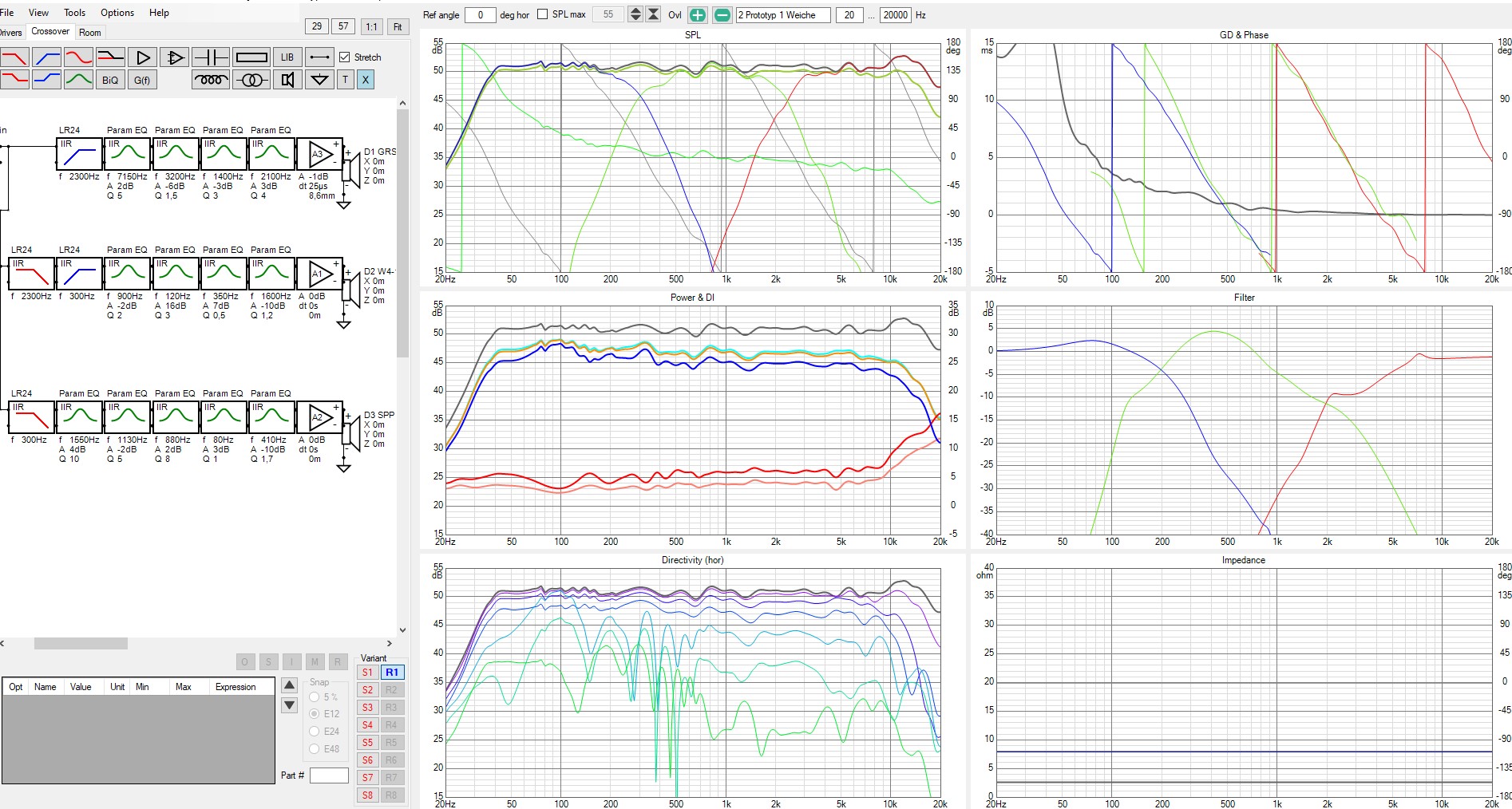 [/URL]
[/URL]
The measurement was taken from 1 m between the GRS and the W4-1320. The microphone was also 1m from the grond level away.
My speaker "enclosure" has a high of 80cm. Therefore i got many reflections in the LF from the Ground and these can be see especially at 60,75, and 90 degree. At least i think so. All data are smoothed 1/6 (IR 6ms).
I will make additional measurements with the LF on a higher Table.
The Sub-Part of the LF i got from a nearfieldmeasurement for dipoles and merged them with the 1m Measurement of the LF.
Problems:
- The LF part (my H-Frame) give bad results for 60, 75, 90 Degree. I hope this will change with the new measurements.
- I still have to make a good mounting for my W4-1320; to get rid of the higher distortion at 500-600Hz.
Any ideas?
Btw. i orderd 2 more PCM5102...
ANd i got a recommendation for the Hanzou TPA3251. I could order 3 of them. Waht do you think?

https://i.postimg.cc/dtmnsTR3/IMG-20210524-154228.jpg

[url=https://ibb.co/n1xTwqH][IMG]https://i.ibb.co/2MGwF0D/IMG-20210524-154252.jpg[/IMG][/url]
Crossover:
I have measured my prototype on and off axis and put them in vituix cad. Some adjustments and LR24 gived this result:

Here bigger:[URL=https://www.directupload.net]
 [/URL]
[/URL]The measurement was taken from 1 m between the GRS and the W4-1320. The microphone was also 1m from the grond level away.
My speaker "enclosure" has a high of 80cm. Therefore i got many reflections in the LF from the Ground and these can be see especially at 60,75, and 90 degree. At least i think so. All data are smoothed 1/6 (IR 6ms).
I will make additional measurements with the LF on a higher Table.
The Sub-Part of the LF i got from a nearfieldmeasurement for dipoles and merged them with the 1m Measurement of the LF.
Problems:
- The LF part (my H-Frame) give bad results for 60, 75, 90 Degree. I hope this will change with the new measurements.
- I still have to make a good mounting for my W4-1320; to get rid of the higher distortion at 500-600Hz.
Any ideas?
Btw. i orderd 2 more PCM5102...
ANd i got a recommendation for the Hanzou TPA3251. I could order 3 of them. Waht do you think?
Attachments
Last edited:
That shouldnt be a problem then. Did you think about a horn for the highs?
Thank you. I have bought 1 month ago the grs 3 planar. So i will first give a try.
BUt i thought about horns before. The idea was to get a dipole pattern to back and front. It is possible with horns (i think gainphile showed that) but you get additional compromises in the vertical plane, because o the big driver distance.
At the End we have to look what is more important, and which compromises dont compromise the sound
 . I think if the max SPL would be somewhat more important, the way with horn sould be much better in 3 Way.
. I think if the max SPL would be somewhat more important, the way with horn sould be much better in 3 Way.We will see if the w4-1320 will stay or fall...
I have now good measurement from the H-Frame (without smoothing; 6ms):
 [/URL][/IMG]
[/URL][/IMG]
In the future i could measure the W4-1320 again.... for 90 and 75 degrees...
But now they look like this:
 [/URL][/IMG]
[/URL][/IMG]
I could make some additionally automated PEQ with REW and import it to Sigmastudio. Any suggestions?
Best regards, Tomas

In the future i could measure the W4-1320 again.... for 90 and 75 degrees...
But now they look like this:

I could make some additionally automated PEQ with REW and import it to Sigmastudio. Any suggestions?
Best regards, Tomas
It is impossible to measure H-frame OB bass correctly in the room, nearfield measurement will not count dipole cancellation nearly at all. To get this small size H-frame bass FR direct to to 40 Hz you need much more correction than +3 dB on 80 Hz. I had find with AKABAK simulations that needed is +10 to +15 dB EQ on 40 Hz. Something similar as in mid range where is used +16 dB and +7 dB EQ.
It is impossible to measure H-frame OB bass correctly in the room, nearfield measurement will not count dipole cancellation nearly at all. To get this small size H-frame bass FR direct to to 40 Hz you need much more correction than +3 dB on 80 Hz. I had find with AKABAK simulations that needed is +10 to +15 dB EQ on 40 Hz. Something similar as in mid range where is used +16 dB and +7 dB EQ.
I combined the measurements at 1m with nearfield-measurements. This is described here:
measure a dipole
But yes, its a approxmation, to start with. Later i will add a room correction.
And perhaps i will measure one time outside on a parkingplace or something. Probably in the summer...
I presumed you measured bass only as near filed from small amount of used EQ level. But you made also "Sum near field response to itself with phase inversion and delay"?
Here is image how looks H-frame Akabak FR simulation form 1 m, frame depth is 300mm front and 300 mm rear, two 12" speakers located nearly as in your H-frame.
Here is image how looks H-frame Akabak FR simulation form 1 m, frame depth is 300mm front and 300 mm rear, two 12" speakers located nearly as in your H-frame.
Attachments
Last edited:
I presumed you measured bass only as near filed from small amount of used EQ level. But you made also "Sum near field response to itself with phase inversion and delay"?
Hi kaameelis, yes. I can attach you the merged response for the H-Frame (dipol nearfield, like you described + 1m farfield), and get this response without PEQ:
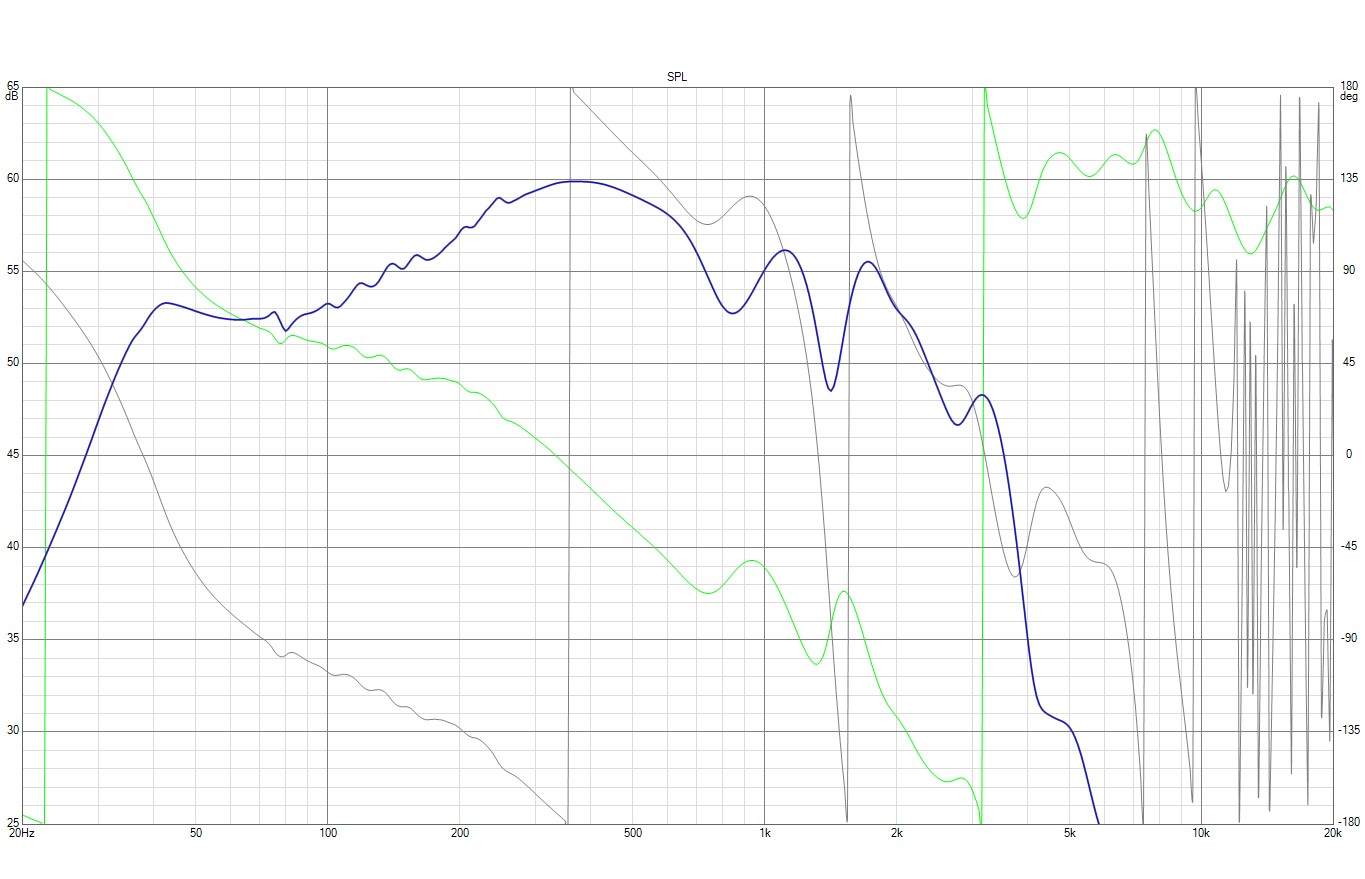
I think its not to far away from your akabak simualtion. The SPP-250 has an Qts of 0,92, if its important for your simulation with fs at 30Hz. H-Frame differs a little bit of course. And my lowest Room Mode should be between 35-45Hz.
The H-Frame is 31,4cm bright and has a depth of 20cm. The SPP-250 is a 10inch driver.
Last edited:
OK, you had big room influence in measurements at 40 Hz. I thought it is presenting free field FR what must fall from dipole peak nearly constantly with slope 6dB/octave.
I can simulate it on Akabak. is H-frame depth 20 cm to forward and also 20 cm to rear side? Are height and width 31.4 cm, is this internal or outer measurement?
I can simulate it on Akabak. is H-frame depth 20 cm to forward and also 20 cm to rear side? Are height and width 31.4 cm, is this internal or outer measurement?
OK, you had big room influence in measurements at 40 Hz. I thought it is presenting free field FR what must fall from dipole peak nearly constantly with slope 6dB/octave.
I can simulate it on Akabak. is H-frame depth 20 cm to forward and also 20 cm to rear side? Are height and width 31.4 cm, is this internal or outer measurement?
I have measured nearfield LF like in this photo:

After that i merged the nearfield-measurement for LF with the higher frequency part of the 1m measurement.
The depth is overall 20cm. The width 31,4 cm is outer measurement. The High is approx. 60cm.
Btw, the room is 4m x 4,8m x 2,5m. At 4m with sloped ceilings.
Your akabak measuremet would be very interesting. 🙂
Your akabak measuremet would be very interesting. 🙂
You missing probably one step to get H-frame LF measurement. You need to add to measured near field response same response with phase inversion and delay. Delay in your case is 20 cm sound travel time.
Simulation result are like this. I take H-frame panel thickness 20 mm, SPP-250 T/S parameters are form Monacor page. Dipole peak and 40 Hz level difference is more than 20 dB, you get only 7 dB.
Simulation result are like this. I take H-frame panel thickness 20 mm, SPP-250 T/S parameters are form Monacor page. Dipole peak and 40 Hz level difference is more than 20 dB, you get only 7 dB.
Attachments
- Home
- Loudspeakers
- Multi-Way
- 3-Way OB - get the best out


